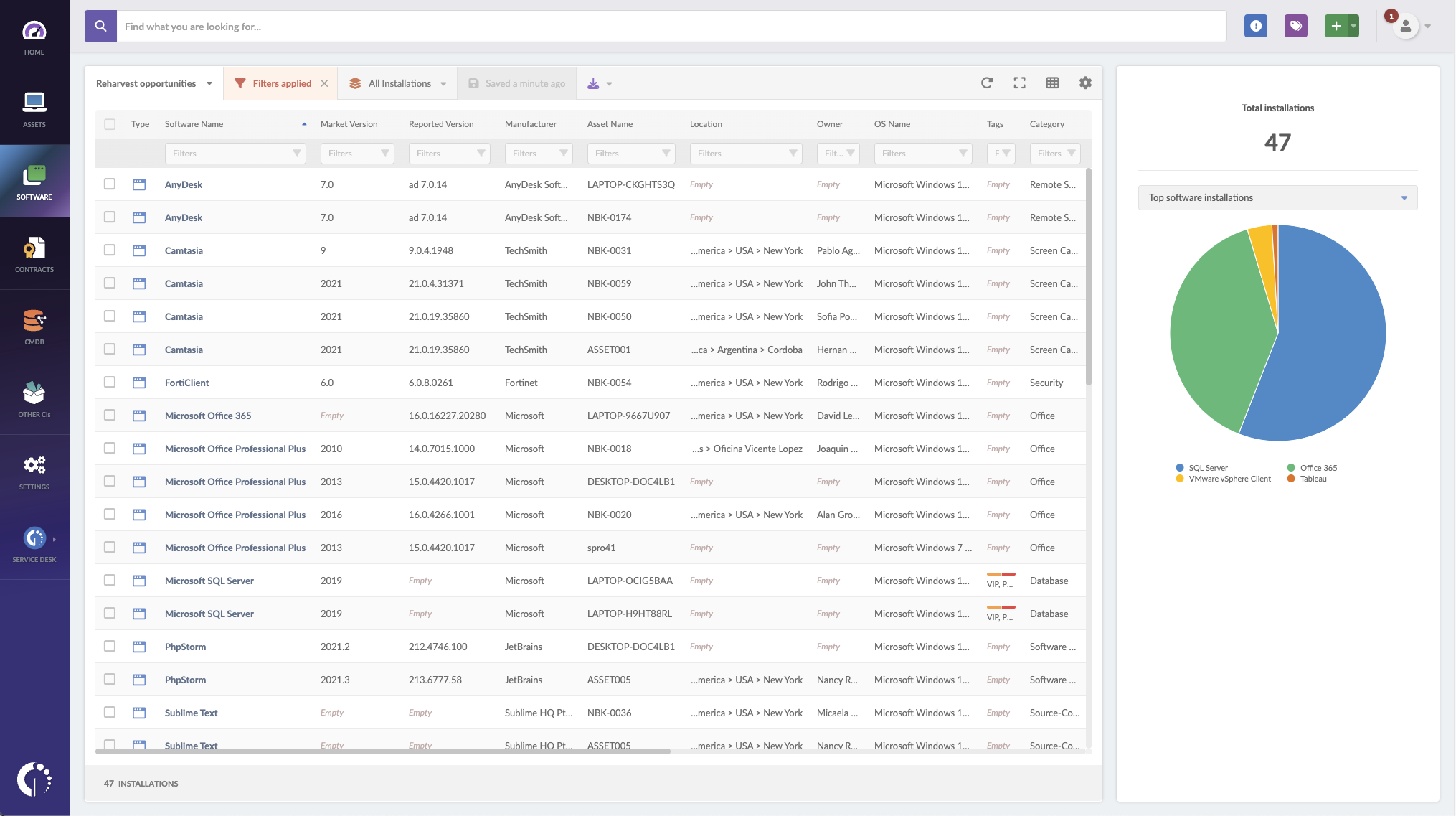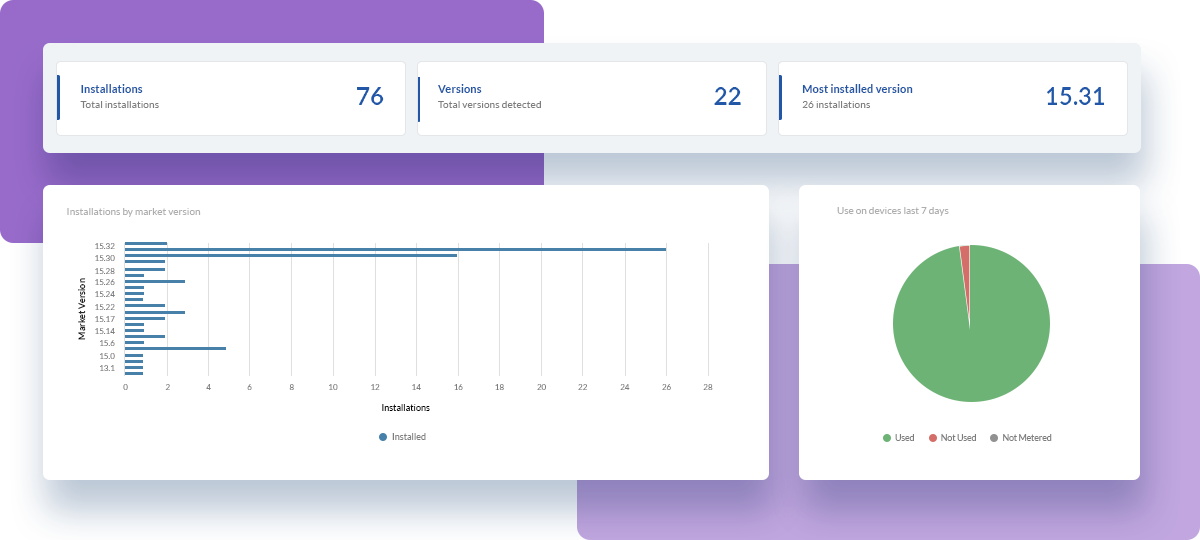License harvesting allows organizations to optimize their software investments and reduce overall IT costs. Detecting unused licenses is especially relevant since roughly half of all installed software and licensed SaaS applications are unused by employees – costing organizations approximately $44,743,651 per month.
This process is central to an efficient License Management strategy, but this is not always easy or straightforward – especially if you don’t have any IT Asset Management tools in place.
In the following article, we will further explore the operations involved in detecting unused software and show you how to optimize the process with InvGate Asset Management.
Let’s jump right in!
Software harvesting definition
Under the realm of Software Asset Management, license harvesting looks to identify application licenses that are not currently in use and take the appropriate actions to reallocate them.
Software can go unused for many reasons, and it’s quite easy for it to go unnoticed. Sometimes, the license might be uninstalled from the machine, the user can be no longer active, or they are just not using it.
Whichever the reason, this process allows you to recover these licenses to either retire them or assign them to a different user, thus reducing software spend on new licenses and annual maintenance costs.
5 benefits of license harvesting
Periodic license harvesting is not all about saving money (although it is a pretty important perk!). It also helps to maintain software compliance and an overall better control of your IT environment. Let’s explore some of the significant advantages it offers:
- Cost savings - This is the main and more notorious benefit. By eliminating the financial burden of unused licenses, your business can optimize its software investments and allocate resources more efficiently.
- Improved License Management - Organizations also gain better visibility into their software inventory, better understand license utilization patterns, and can detect unauthorized software to make informed decisions regarding license allocation. Therefore, they can ensure compliance with licensing agreements and avoid the risk of non-compliance penalties.
- Resource optimization - By reallocating licenses to areas in need, you can enhance productivity and ensure that software is effectively utilized across the organization.
- Shadow IT identification - Thoroughly analyzing software usage data during the harvesting process helps you identify instances where employees may be utilizing unauthorized or pirated software. This knowledge allows organizations to mitigate security risks, enforce software compliance policies, and improve overall data governance.
- Future planning and budgeting - License harvesting also enables organizations to make more accurate future planning and budgeting decisions since it cuts unnecessary costs and allows for a better distribution of licenses.
How software harvesting works
The first step in the software harvesting process is to identify unused software. Once you have spotted these licenses, it’s time to decide what to do with them. So, the next step consists in classifying these installations to either be reassigned or removed.
It’s important to keep a register of its current ownership and/or availability and incorporate this information to the rest of the Software Management details associated with that asset.
You can meter software usage and reassign and remove the licenses manually, by going into every user’s computer, or via a directory tool. However, this can be tedious, time consuming, and prone to errors.
Implementing a License Management tool will give you a bird’s eye view of the situation and help make sure no license is overlooked - and that’s exactly what InvGate Asset Management does. So, let’s see how it works.
How to identify devices with unused software licenses with InvGate Asset Management

InvGate Asset Management allows you to easily see the usage of any software installed on your organization’s computers thanks to its Software Metering feature. When enabled, it monitors the software usage in your IT ecosystem, providing a level of detail and insight that is practically impossible otherwise.
But before we see how to identify licenses to harvest with InvGate Asset Management, remember that you have to install the Agent on your organization’s devices so that they can report to your instance.

Now that’s all settled, all you need to do is create the following filters to have a view of the software usage:
- Computer >> Software Installations >> Average usage in the last X days is Y min
- Software Installations >> License Classification is Paid
Once you apply them, you can easily go back to that view whenever you want to monitor your active licenses and identify under usage.
How to report on unused or underused software licenses

Let’s say you detected a bunch of inactive or underutilized licenses. The next step in the process is to generate a report to take action. To do so, InvGate Asset Management’s software summary page shows you an overview of the organization's licenses.
By regularly visiting this page, you can identify unused and underused licenses, which are organized in a dashboard view. You also have access to other relevant information, such as software title, the number of licenses owned, and how many are in use.
And for the reporting part, you can export and share these findings by generating a report on the software summary page, highlighting the specific licenses that are not actively utilized. This provides a clear visual reference for the unused licenses, making the information more accessible and understandable for stakeholders.
How to reclaim software licenses
After identifying and reporting on the unused or underused licenses, the next step is to reclaim them. To do so, first you have to coordinate the process with the appropriate department or team and get them on board.
Then, the reclaim procedure includes updating license records, adjusting license counts, or modifying license allocation according to the organization's Licensing Management process.
A good way to do this is by using InvGate Asset Management’s remote desktop integrations to access the user’s computer and complete the tasks. Once it’s done, you will automatically see the available license in your instance.
Another way to do this is through Active Directory (AD) or Microsoft Entra ID (formerly Azure Active Directory). This allows you to remove the employee's access to the software by adjusting the user's permissions or access rights within the directory service. For this change to be automatically reflected in your inventory, however, AD has to be integrated with InvGate Asset Management.
4 best practices to reharvest software
The process of reclaiming unused or underused licenses requires careful planning and execution. Here are four best practices to ensure a successful and efficient reharvesting process:
- Set up a regularly scheduled review of unused software - Systematic analysis of software usage data helps you detect licenses that are no longer actively utilized before they cause too much waste. This practice ensures that reharvesting remains an ongoing and consistent effort within the organization.
- Review usage prior to contract renewal - Conduct a thorough evaluation of the software licenses you need to renew to determine their current utilization prior to the contract’s due date and compare it against the number of licenses owned to identify potential opportunities for reharvesting. Pro tip: you can automate notifications on InvGate Asset Management to receive an alert whenever a contract is about to expire.
- Maintain clear documentation and record-keeping - Log all your efforts related to the license reharvesting process (including identification, actions, reallocation, and cost savings). Clear documentation helps ensure accountability and provides valuable information for future License Management initiatives. It also serves as a reference for auditing purposes and can assist in demonstrating compliance with licensing agreements.
- Treat people with respect and kindness - Removing access to licenses that people may have used actively in the past can cause some discomfort. So, it’s essential that you can communicate the decision with empathy to encourage cooperation. Offering alternative solutions or assistance in finding suitable replacements can also help ease the transition and minimize any potential disruption.
Wrapping up
License harvesting is a proactive ITAM practice that focuses on identifying and reclaiming unused software licenses within an organization's inventory. It empowers asset managers to take control of the software license inventory, reduce costs, and optimize resource allocation.
As you embark on your license harvesting journey, remember that it is a continuous process. Regular reviews, effective communication, and proactive management are key to sustained success. Remember, every license that you reuse is one that you don’t re-purchase, and every installation you retire is money that you are not throwing away.
To embrace the power of license harvesting, ask for InvGate Asset Management’s 30-day free trial!















